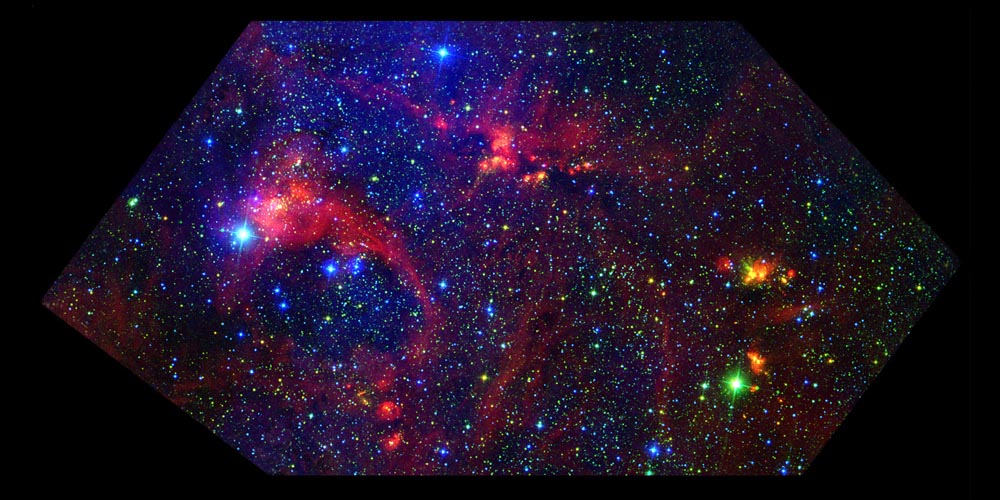
Description: Star forming region in dark cloud
Position (J2000): RA: 20h39m0.90s Dec: 42d19m57.00s
Distance: 2000 parsecs (6200 light-years)
Constellation: Cygnus
Instrument: IRAC
Wavelength: 3.6 (blue), 4.5 (green), 5.8 (orange), 8.0 (red) microns
Exposure Date: October 11, 2003 & November 22, 2003
Exposure Time: 5 seconds per position
Image scale: 61 x 37 arcmin
Orientation: North is 88 deg CW from up
Image Credit: NASA/JPL-Caltech/A. Marston (ESTEC/ESA)
Release Date: April 13, 2004
ABOUT THIS IMAGE:
Hidden
behind a shroud of dust in the constellation Cygnus lurks one of the most
violent pockets of star birth in our galaxy. Called DR21, this stellar
nursery is so draped in cosmic dust that it appears invisible to the human
eye. Visible light images reveal no trace of this interstellar cauldron
because of heavy dust obscuration. In fact, visible light is attenuated
in DR21 by a factor of more than 10,000,000,000, 000,000,000,000,000,000,000,000,000,000
(ten thousand trillion heptillion). By seeing in the infrared, NASA's
Spitzer Space Telescope has pulled this veil aside, revealing a fireworks-like
display of massive stars.
This colorful image is a large-scale composite mosaic assembled from data
collected at a variety of different wavelengths. Views at visible wavelengths
appear blue, near-infrared light is depicted as green, and mid-infrared
data from the InfraRed Array Camera (IRAC) aboard NASA's Spitzer Space
Telescope is portrayed as red. The result is a contrast between structures
seen in visible light (blue) and those observed in the infrared (yellow
and red). The image covers an area about two times that of a full moon.
The
biggest of these stars is estimated to be 100,000 times as bright as our
own Sun. "We've never seen anything like this before," said Dr. William
Reach, an investigator for the latest observations and an astronomer at
the Spitzer Science Center, located at the California Institute of Technology,
Pasadena, Calif. "The massive stars are ripping the cloud of gas and dust
around them to shreds." The principal investigator is Dr. Anthony Marston,
a former Spitzer astronomer now at the European Space Research and Technology
Centre, the Netherlands.
Located about 10,000 light-years away in the Cygnus constellation of our
Milky Way galaxy, DR21 is a turbulent nest of giant newborn stars. The
region is buried in so much space dust that no visible light escapes it.
Previous images taken with radio and near-infrared bands of light reveal
a powerful jet emanating from a huge, nebulous cloud. But these views
are just the tip of the iceberg. Spitzer's highly sensitive infrared detectors
were able to see past the obscuring dust to the stars behind. The new
false-color image spans a vast expanse of space, with DR21 at the top
center.
Within DR21, a dense knot of massive stars can be seen surrounded by a
wispy cloud of gas and dust. Red filaments containing organic compounds
called polycyclic aromatic hydrocarbons stretch horizontally and vertically
across this cloud. A green jet of gas shoots downward past the bulge of
stars and represents fast-moving, hot gas being ejected from the region's
biggest star.
Below DR21 are distinct pockets of star formation, never captured in full
detail before. The large swirling cloud to the lower left is thought to
be a stellar nursery like DR21's, but with smaller stars. A bubble possibly
formed by a past generation of stars is visible within the lower rim of
this cloud. The new view testifies to the ability of massive newborn stars
to destroy the cloud that blankets them. Astronomers plan to use these
observations to determine precisely how such an energetic event occurs.